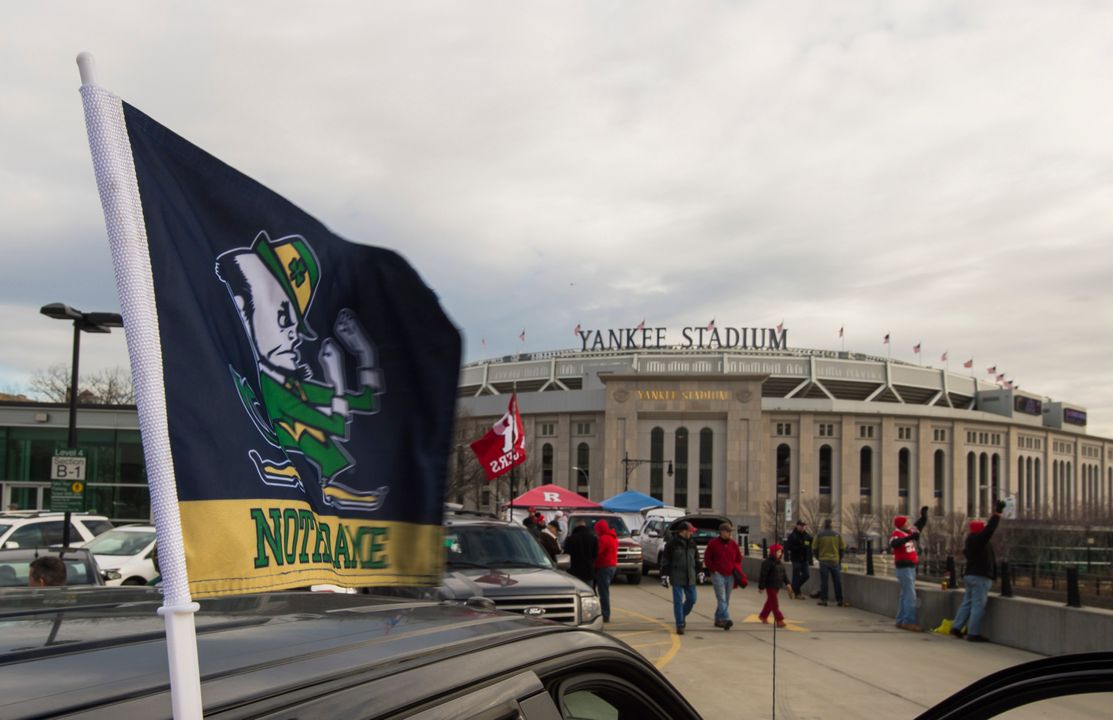Notre Dame heads to Yankee Stadium to face Syracuse this weekend, riding a heady wave of back-to-back 10-win seasons. But the last time the two teams met in that world-famous arena, 55 years ago this month, it was a desperate time for the Irish. In fact, arguably it stands as the lowest point of Notre Dame’s football history.
I know. I was the senior manager of that 2-7 1963 team.
Under cloudy skies with temperatures in the low 40s, the Syracuse home game was played on Thanksgiving Day before 56,672 in the old Yankee Stadium, the House That (Babe) Ruth Built. I recall the thrill of coming out through the third-base dugout onto that hallowed field, then also the home of the NFL’s New York Giants. The “new” Yankee Stadium opened in 2009.
We had already lost six of our eight games, one having been cancelled the previous weekend after the assassination of President John F. Kennedy. We had been due to play the University of Iowa in Iowa City. The game was called after we had already settled into our Iowa City motel. We flew back to South Bend on Sunday morning, with a quick turnaround before our charter to New York at midday Wednesday. As if the death of JFK hadn’t spread enough gloom, the Studebaker automobile company declared that month that it was going out of business, leaving South Bend with an uncertain economic future. I recall that the company president, looking like a beaten man, flew with us to New York.
Still, as always, we traveled with class and checked into the Waldorf Astoria. This was the last year of single-platoon college football. Our traveling squad numbered less than 40 players, so we fit on a single bus that glided up to the motor entrance of the Waldorf off East 49th Street just as darkness fell. There was no time for a walk-through at the stadium. We had a film session in our hotel and retired early. Kickoff, I recall, was at the strange time of 10:30 a.m.
Led by Frank Budka at quarterback, the Irish at one point led 7-6, only to have Syracuse score the decisive touchdown on a pass from Rich King to Mike Koski with 3:28 left on the clock. It was our fourth late-score loss of the season.
As the final whistle blew, I met Henry Huttner, a friend from my hometown of Springfield, Massachusetts, who was a starting tackle for the Orangemen. He said, “Tough game, Matt.” I said, “Just like all the others.” It was that kind of season, and it punctuated a decade of mediocrity for Notre Dame after the glory years of the early 1950s under Frank Leahy. In fact, 1963 was the fifth consecutive season without a winning record.
A footnote: The Irish wore green jerseys that day in 1963 and would not wear them again until the USC game in 1977.
Over the years, I enjoyed telling fellow alums that only two classes have gone through Notre Dame without a single winning season, mine (1964) and 1963 (ask former University president Rev. Edward “Monk” Malloy, C.S.C.).
Referring to our coach, Hugh Devore, lead New York Times sports columnist Arthur Daley wrote, “Hughie Devore’s operatives certainly don’t even remotely resemble in talent the powerhouse teams that Frank Leahy once put on display in this same arena.”
But, in fact, we did have some great players: Among others, John Huarte, a reserve quarterback who would win the Heisman Trophy the following year; Jim Kelly, an outstanding receiver; Jack Snow, another receiver who in 1963 was misplaced as a halfback; Bill Wolski, another halfback; and Bob Lehmann, team captain and linebacker. By my count, eventually at least 17 players from that team would play professional football. John Meyer, a lineman, became an assistant NFL coach at Detroit, New England and Green Bay. Dan McGinn, a punter, was a successful Major League Baseball pitcher. Mike Wadsworth, a reserve lineman, served as Notre Dame’s director of athletics from 1995 to 2000.
In the visitors’ locker room after the game, I was excited to see soft-spoken Red Smith of The New York Herald Tribune interviewing Lehmann. A 1927 Notre Dame alum, Smith is widely regarded as one of the most talented sportswriters of his time and one of the very few to win a Pulitzer Prize. As an aspiring journalist, I might have to concede that seeing Red Smith in action was the best moment of a tough day.
Don’t think that the players on that 1963 team didn’t feel the weight of not living up to the legends. Most of us stayed over in the city, given $75 each — a generous sum in those days — to get back to campus whatever way we could. Over the course of the weekend, without betraying confidences, I can say a number of players had teary emotional letdowns over the course of those days, and Devore, named an interim coach only the previous April, held morose court in his Waldorf suite.
There was no way for any of us to know that this day was rock bottom. Eighteen days later, it was announced that Northwestern’s young coach had agreed to take over at Notre Dame.
A guy named Ara Parseghian was on his way to South Bend.
A 1964 University of Notre Dame graduate, Matt Storin is a retired newspaper editor who later served as an administrator and faculty member at Notre Dame.







